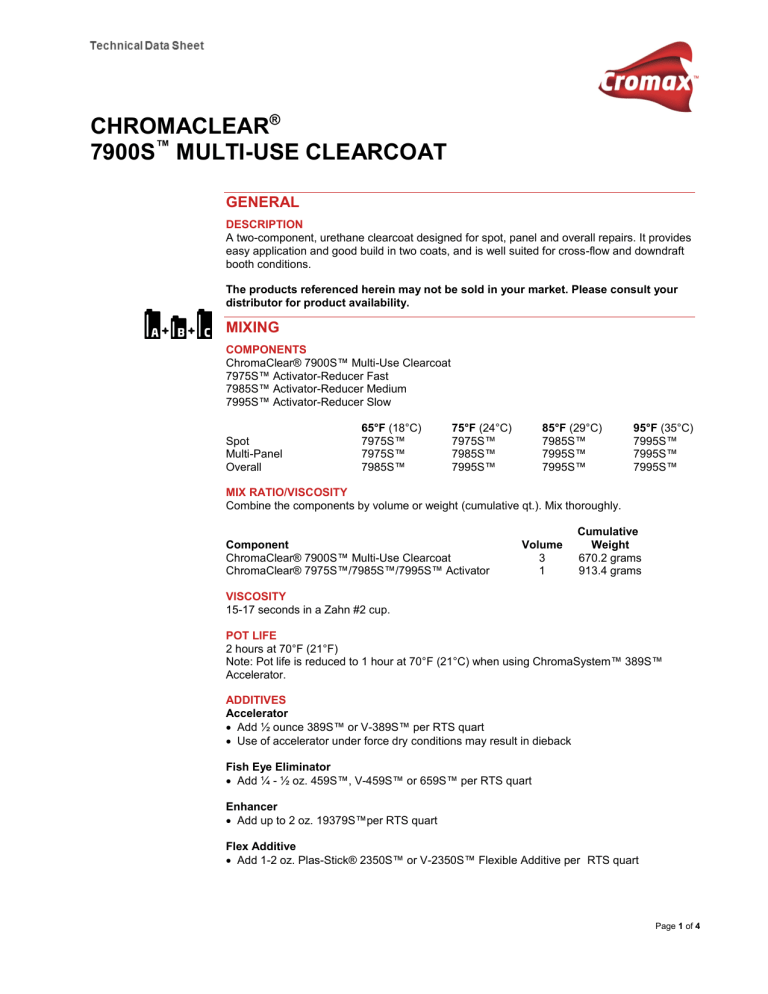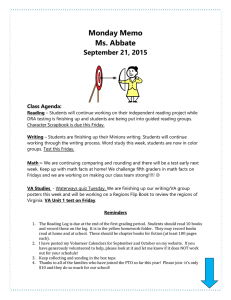ChromaClear 7900S Clearcoat: Technical Data & Application Guide
advertisement

CHROMACLEAR® 7900S™ MULTI-USE CLEARCOAT GENERAL DESCRIPTION A two-component, urethane clearcoat designed for spot, panel and overall repairs. It provides easy application and good build in two coats, and is well suited for cross-flow and downdraft booth conditions. The products referenced herein may not be sold in your market. Please consult your distributor for product availability. MIXING COMPONENTS ChromaClear® 7900S™ Multi-Use Clearcoat 7975S™ Activator-Reducer Fast 7985S™ Activator-Reducer Medium 7995S™ Activator-Reducer Slow Spot Multi-Panel Overall 65°F (18°C) 7975S™ 7975S™ 7985S™ 75°F (24°C) 7975S™ 7985S™ 7995S™ 85°F (29°C) 7985S™ 7995S™ 7995S™ 95°F (35°C) 7995S™ 7995S™ 7995S™ MIX RATIO/VISCOSITY Combine the components by volume or weight (cumulative qt.). Mix thoroughly. Component ChromaClear® 7900S™ Multi-Use Clearcoat ChromaClear® 7975S™/7985S™/7995S™ Activator Volume 3 1 Cumulative Weight 670.2 grams 913.4 grams VISCOSITY 15-17 seconds in a Zahn #2 cup. POT LIFE 2 hours at 70°F (21°F) Note: Pot life is reduced to 1 hour at 70°F (21°C) when using ChromaSystem™ 389S™ Accelerator. ADDITIVES Accelerator Add ½ ounce 389S™ or V-389S™ per RTS quart Use of accelerator under force dry conditions may result in dieback Fish Eye Eliminator Add ¼ - ½ oz. 459S™, V-459S™ or 659S™ per RTS quart Enhancer Add up to 2 oz. 19379S™per RTS quart Flex Additive Add 1-2 oz. Plas-Stick® 2350S™ or V-2350S™ Flexible Additive per RTS quart Page 1 of 4 APPLICATION SUBSTRATES ChromaPremier® Basecoat ChromaBase® Basecoat 222S™ Midcoat Adhesion Promoter for blend areas Properly prepared OEM topcoat SURFACE PREPARATION For application over a properly prepared basecoat repair: Mask the entire vehicle to protect from overspray. Allow basecoat to dry 15-30 minutes. Extend basecoat dry time to 30 minutes when applying several base color coats, and/or in cooler shop conditions. GUN SETUPS* Compliant HVLP 1.4 mm-1.6 mm 1.4 mm-1.6 mm AIR PRESSURE* Compliant Siphon Feed Gravity Feed Panel 40-45 psi at the gun 35-45 psi at the gun Overall 45-50 psi at the gun 40-45 psi at the gun HVLP 6-8 psi at the gun cap 8-10 psi at the gun Note: Refer to the manufacturer’s directions for gun specific recommendations. APPLICATION Apply 2 medium-wet coats. Flash 10 minutes between coats. DRY TIMES AIR DRY Dust Free: Time to Handle (Assemble): Time to Polish: Time to Stripe: Time to Deliver: Time to Decal: 15-20 minutes Overnight Overnight Overnight Overnight After 72 hours FORCE DRY Flash before Force Dry: Dust Free: Cycle Time: Time to Handle (Assemble): Time to Polish: Time to Stripe: Time to Deliver: Time to Decal: Not required At cool down 30 minutes at 140°F (60°C) After cool down 2-3 hours after cool down 2-3 hours after cool down 2-3 hours after cool down 24-72 hours INFRARED Refer to the Infrared Guide for setup recommendations BLENDING Panel repair is the approved procedure for clearcoat warranty repairs. This allows the refinisher to attain the recommended film builds. If the refinisher chooses to blend, use 19301S™ Clearcoat Blender. After the final coat of clearcoat, step-out the coating by mixing 1 part 19301S™ Clearcoat Blender to 1 part of the remaining material and taper the blend with the resulting mixture. Page 2 of 4 Place 19301S™ Clearcoat Blender in a clean spray gun and taper the blend edge for final melt-in of the blended edge. Tip for Success For sail panel blending, be sure 222S™ Midcoat Adhesion Promoter is applied beyond the intended clearcoat area. RECOATABILITY/RE-REPAIR ChromaClear® 7900S™ Multi-Use Clearcoat may be recoated during any stage of dry or cure. If recoating after 24 hours, scuff sand with 1200-1500 grit. CLEANUP Clean spray equipment as soon as possible with lacquer thinner. SANDING, COMPOUNDING, POLISHING The optimum technique for removing dirt is as follows: SANDING Use 1500 grit wet or finer or use a foam interface pad with P1500 DA or finer. COMPOUNDING Apply a thin ribbon of rubbing compound to the area that was sanded or contains sand scratches. Maintain air polisher or variable speed buffer at 1400-1800 rpm. Remove excess finishing compound with a clean soft cloth prior to applying finishing polish. Use a wool pad and an effective rubbing compound. Use finishing compound. Apply a thin ribbon of material to the area to be polished. Use a double-sided wool polishing pad or a foam pad. Maintain air polisher or variable speed buffer at 1500-1800 RPM. Remove excess finishing compound with a clean soft cloth prior to applying finishing polish. POLISHING Apply a ribbon of polishing material to the area to be polished. Maintain a variable speed buffer or an orbital polisher at 1400-1800 rpm. Use a foam pad and an effective polishing compound. Keep the polisher/buffer moving at all times. Overlap each pass approximately 50%. As finishing polish begins to dry, stop polishing. Wipe off excess finishing polish with a clean soft cloth. Hand buff with a clean soft cloth as a finishing touch. Use finishing polish (shake well before using). Apply a ribbon of material to work a 2-3 foot square area. Use a foam pad or a terry cloth cover. Maintain a variable speed buffer or an orbital polisher at 1200-1800 RPM. Keep the polisher/buffer moving at all times. Overlap each pass approximately 50%. As finishing polish begins to dry, stop polishing. Wipe off excess finishing polish with a clean soft cloth. Hand buff with a clean soft cloth as a finishing touch. Tips for Success Always use clean water to wet sand and add a few drops of soap to help clear the paper. Always use a foam interface pad when DA sanding. Use clean cloths and pads to insure that the clear does not get scratched with dirt Do not use medium to heavy-duty compounds. Use clean cloths and pads to insure that the clear does not get scratched with dirt particles from old or re-used cloths or pads. Do not wax for the first 120 days after painting. Page 3 of 4 PHYSICAL PROPERTIES All Values Ready To Spray Max. VOC (LE): Max. VOC (AP): Avg. Gal. Wt.: Avg. Wt.% Volatiles: Avg. Wt.% Exempt Solvent: Avg. Wt.% Water: Avg. Vol.% Exempt Solvent: Avg. Vol.% Water: Theoretical Coverage: Recommended Dry Film Thickness: Flash Point: 513 g/L (4.3 lbs./gal) 453 g/L (3.8 lbs./gal) 968 g/L (8.08 lbs./gal) 55.7% 10.7% 0.0% 12.6% 0.0% 598 sq. ft. per RTS gallon at 1 mil 1.8-2.2 mils in 2 coats See MSDS/SDS VOC REGULATED AREAS These directions refer to the use of products which may be restricted or require special mixing instructions in VOC regulated areas. Follow mixing usage and recommendations in the VOC Compliant Products Chart for your area. SAFETY AND HANDLING For industrial use only by professional, trained painters. Not for sale to or use by the general public. Before using, read and follow all label and MSDS/SDS precautions. If mixed with other components, mixture will have hazards of all components. Ready to use paint materials containing isocyanates can cause irritation of the respiratory organs and hypersensitive reactions. Asthma sufferers, those with allergies and anyone with a history of respiratory complaints must not be asked to work with products containing isocyanates. Do not sand, flame cut, braze or weld dry coating without a NIOSH approved air purifying respirator with particulate filters or appropriate ventilation, and gloves. Revised: September 2014 Page 4 of 4

